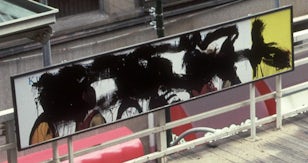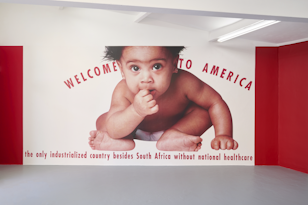Three couples line the wall, face to face. They are kissing tenderly. A gingerly affectionate straight pairing on the left, two men in the middle, two gleeful women on the right. One half of the central couple has his mouth open so wide he seems intent on engulfing his partner, who leans in willingly nonetheless. The two women seem especially unable to contain their joy in one another: it leaks out the sides of their mutually nipping mouths in grins so large that they crinkle the eyes. Six figures in all, they are affection, desire and exultation in three acts.

When Gran Fury’s Kissing Doesn’t Kill: Greed and Indifference Do first appeared plastered prominently over Chicago’s public spaces in 1990, its purpose was to combat the panic-circulated myth that the human immunodeficiency virus could be transmitted through saliva. The posters and billboards were routinely defaced: a growing and pervasive narrative positioning HIV as a threatening epidemic ‘fuelled by gay promiscuity’ 01 led city inhabitants in anger to cross out all the kissing figures within two days. 02 The adoption of this narrative during the emergence of the acquired immune deficiency syndrome as a global health crisis in the early 1980s tore gashes into the hard-won, tentatively liberalising US attitudes towards homosexuality at the time. Gran Fury emerged from ACT UP (the AIDS Coalition to Unleash Power), the now-influential activist group who sought to combat governmental negligence of the blooming AIDS catastrophe at both policy and societal level. The overt messaging of Kissing Doesn’t Kill overlays a more subtle, embedded communication: that queerness is and was also joy, even amid the chaotic emergence of AIDS. This work’s positive expression of queer sexuality can be viewed almost in opposition to General Idea’s iconic AIDS (1986), which through its open appropriation of Robert Indiana’s LOVE (1967) 03 always contained the paradox: if love is directly replaceable by AIDS, which remains incurable and at the time signified a swiftly-advancing death, what was the potential for queer expressions of love? Were queer love and AIDS to be polarised, thereby implied as binarily inevitable?
The overt messaging of Kissing Doesn’t Kill overlays a more subtle, embedded communication: that queerness is and was also joy, even amid the chaotic emergence of AIDS.
In the late 20th century the idea of gayness as an identity was slowly replacing the mainstream assumption of a ‘lifestyle choice’, as well as some former fluidity between sexual activity and LGBT identity categories, particularly for men who had sex with men. This gave the disease’s emergence a particularly complex ontological relationship to that identity: with no cure, diagnosis often meant a forced ‘coming out’. Because of their marginalisation and socio-sexual positioning the outbreak of AIDS particularised queer men as victims. But Gran Fury’s messaging urged for that victimhood to be seen on a collective rather than individual level: combatted through urgent changes to the derelict public health policy (five years into the epidemic at the end of 1986, there had been over 28,700 diagnosed cases and over 25,500 deaths; the same year then-president Reagan had only just uttered the word ‘AIDS’ in public) 04 as well as to the public perception that AIDS was confined to certain communities. That victimhood was not inherent in the nature of queerness, but a result of government negligence and social and political marginalisation, was radical messaging to reach the mainstream. That there was cause for joy in same-sex kissing – that queerness was not death – was similarly so.
Kissing Doesn’t Kill is a central work in ‘ Read My Lips’ , Gran Fury’s first comprehensive retrospective in the UK. Currently showing at Auto Italia South East’s project space in Bethnal Green, 05 the exhibition marks thirty years since the formation of Gran Fury and ten since the inception of Auto Italia. It has also coincided with the recent American midterms (the US polls remain anxiety-ridden indicators of the immediate concourse of public health down the same party lines) and a revival of interest in the artistic legacy of those associated with the counter-narratives of HIV/AIDS. 06 In this show Gran Fury’s works are reproduced anew: huge billboards and posters in overwhelmingly bright, virile colours. That the aesthetics have barely dated speaks to the sophistication of Gran Fury’s image-making strategies, utilising advertising and media praxis of 1980–90 in order to seamlessly assimilate messaging into spaces where a vast audience could be reached, galvanising and educating the public about the complexities of AIDS. Assisted by the cyclical prevalence of retro aesthetics, the images’ inhabitation of the present is similarly consummate.

That the urgency of the work featured in ‘Read My Lips’ remains palpable is in part thanks to the methods of presentation: the formalities of conventional museological practice are conspicuously lacking, with no interpretive panels to be found. There are only two archival documents, which depict the defacement of billboards in their original context. A selection of oral histories are present on video, in which Gran Fury as a collective (active from 1988–95 and consisting of 11 members including Richard Elovich, Avram Finkelstein, Amy Heard, Tom Kalin, John Lindell, Loring McAlpin, Marlene McCarty, Donald Moffett, Michael Nesline, Mark Simpson and Robert Vazquez-Pacheco) are placed in historical context, though not the disease that catalysed the group’s existence. It’s that particular moment in public health, rather than ongoing global crisis of AIDS itself, that Gran Fury are careful to acknowledge that they are experts in. Across the exhibition there is an effort to avoid historicisation of the illness, also present in the accompanying event series (with contributions from Danielle Brathwaite-Shirley, Otamere Guobadia, Richard John Jones, Harley Yeung Kurlyowski, Carlos Maria Romero, METRO and Jack O’Brien) which invites new perspectives into queer identities, culture and politics, as well as the ongoing AIDS crisis. The exception to this messaging-outside-of-time is perhaps the inclusion in the show of a huge billboard featuring a baby and proclaiming: Welcome to America: The Only Industrialised Country Besides South Africa Without National Healthcare , though this rather accentuates the point: South Africa introduced a policy on universal access to primary healthcare in 1994, 07 six years after the billboard’s conception.

Gran Fury may have been the first to exhort Art Is Not Enough, Seize Power Through Direct Action , 08 but they were simultaneously highly sophisticated makers of complex images, in which ongoing power resides in their inherently mimetic nature. With Barbara Kruger and the Situationists amongst their direct pre-cursors, Gran Fury’s arrangements and proximity of image to text is immediately recognisable as the same aesthetic strategy used today in memes and internet activist culture. The work’s interventional nature is most clear in the use of declarative text – Kissing Doesn’t Kill: Greed and Indifference Do. Corporate Greed, Government Inaction, and Public Indifference Make AIDS a Political Crisis – it smacks of direct action thanks to its invocational potential, inviting the construction of a new reality through language. Phrases like these were written on the back of Gran Fury’s false banknotes, which ACT UP dropped over the trading floor of the NY Stock Exchange during their Wall Street protests in 1989. The protests were particularly targeted towards those seen to profiteer from the price of the drug AZT, which was unaffordable to most people living with HIV. Gran Fury member Marlene McCarty has recalled since: ‘It was kind of fabulous because it stopped trading. The New York Times picked up the story not because of the messages but because it stopped trading. But they had to report on why. Within six to eight weeks, the AZT was lowered [in] price. It had a real effect on people’. 09 If Silence=Death , speaking was a demand and a supplication for life. The banknotes are peppered over Auto Italia’s floor like confetti.
The use of the second person ‘you’ in the work The Four Questions (1993) feels hyper-current in its invitation of confessional response:
Do you resent people with AIDS?
Do you trust HIV negatives?
Have you given up hope for a cure?
When was the last time you cried?
This quiet invitation to consider one’s own body in relation to others is as far as AIDS embodiment goes in the show. There is very little focus on the disease emerging as a biological phenomenon, or utilisation of the ‘sick body’ as a means to accelerate empathy or protest. There are no photos of wasting bodies, no examinations of Kaposi Sarcoma lesions, nor any other AIDS-defining physical marker. These remain crucial images in a wider context, especially as the initial emergence of AIDS strays out of first-hand memory for young people now. But the work of Gran Fury is more attached to a particular moment in US public health: the complex phenomenological context of the disease’s early unfolding, its intersection with multiple marginal identities,the struggle to combat the public perception of the disease as defining particular communities or moral choices. ‘Our loved ones and families were sliding through our fingers. Against this backdrop, a collective response sprang up, focusing our frustration, anger and loss into demands of our government and our cultural institutions. It was the least we could do’. 10 In its recontextualisation as a manageable chronic disease AIDS remains an insidious crisis, but one that has mutated to inhabit new structures of public health and policy. These structures are a direct result of the campaigning of groups like ACT UP and Gran Fury. 11
Footnotes
-
Gran Fury, Read My Lips, London: Auto Italia South East, 2018, p.3.
-
Ibid.
-
Gran Fury later appropriated AIDS by making the counter-painting RIOT http://visualaids.org/blog/detail/before-there-were-memes-there-was-love-aids-riot (last accessed 12 December 2018). See also Gregg Bordowitz, General Idea: Imagevirus, Afterall Books, 2010.
-
See AmfAR, ‘Thirty Years of HIV/AIDS: Snapshots of an Epidemic’, https://www.amfar.org/thirty-years-of-hiv/aids-snapshots-of-an-epidemic/ (last accessed 12 December 2018).
-
See AmfAR, ‘Thirty Years of HIV/AIDS: Snapshots of an Epidemic’, https://www.amfar.org/thirty-years-of-hiv/aids-snapshots-of-an-epidemic/ (last accessed 12 December 2018).
-
‘Read My Lips’ exhibition at Auto Italia 2 October–16 December 2018.
-
The past couple of years have seen re-editions of Derek Jarman’s writings and a resurgence of interest in the work of David Wojnarowicz, culminating in this year’s major retrospective at the Whitney Museum of American Art.
-
See ‘Healthcare in South Africa’, Media Cub South Africa, https://www.mediaclub.co.za/democracy/34-democracy/developmentbg/102-healthcare (last accessed 12 December 2018).
-
Gran Fury, Art Is Not Enough (1988), printed in the Village Voice.
-
Marlene McCarty in Emily Colucci, ‘Is Art Enough? Gran Fury in Perspective’, Hyperallergic, 2012, https://hyperallergic.com/46881/gran-fury-read-my-lips-80-wse-nyu/ (last accessed 12 December 2018).
-
Gran Fury, Read My Lips, op. cit., p.1.
